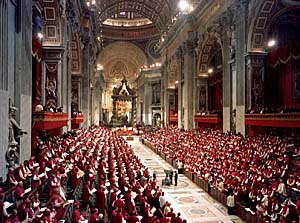 On January 6th, the Holy See issued a series of pastoral recommendations for the Year of Faith, which will begin next October to coincide with the 50th anniversary of the opening of the Second Vatican Council and the 20th anniversary of the promulgation of the Catechism of the Catholic Church.
On January 6th, the Holy See issued a series of pastoral recommendations for the Year of Faith, which will begin next October to coincide with the 50th anniversary of the opening of the Second Vatican Council and the 20th anniversary of the promulgation of the Catechism of the Catholic Church.
The Year of Faith will also coincide with the upcoming Synod of Bishops on the new evangelization.
This bold initiative of Pope Benedict XVI includes all sectors of the Church. Here is what the Holy See suggested concerning the involvement of consecrated men and women in the forthcoming Year of Faith:
“During this time, members of Institutes of Consecrated Life and of Societies of Apostolic Life are asked to work towards the new evangelization with a renewed union to the Lord Jesus, each according to their proper charism, in fidelity to the Holy Father and to sound doctrine.
“Contemplative communities, during the Year of Faith, should pray specifically for the renewal of the faith among the People of God and for a new impulse for its transmission to the young.
“Associations and ecclesial movements are invited to promote specific initiatives which, through the contribution of their proper charism and in collaboration with their local pastors, will contribute to the wider experience of the Year of Faith. The new communities and ecclesial movements, in a creative and generous way, will be able to find the most appropriate ways in which to offer their witness to the faith in service to the Church.”

 The National Catholic Register published last week an article chronicling the journey of fifteen sisters who broke away from their sedevacantist community in 2007 to form the
The National Catholic Register published last week an article chronicling the journey of fifteen sisters who broke away from their sedevacantist community in 2007 to form the  Sr. Mary Eucharista, a member of the
Sr. Mary Eucharista, a member of the  Last week Rorate Caeli published
Last week Rorate Caeli published  In paragraph 24 of Vatican II’s Decree on the Adaptation and Renewal of Religious Life (
In paragraph 24 of Vatican II’s Decree on the Adaptation and Renewal of Religious Life (